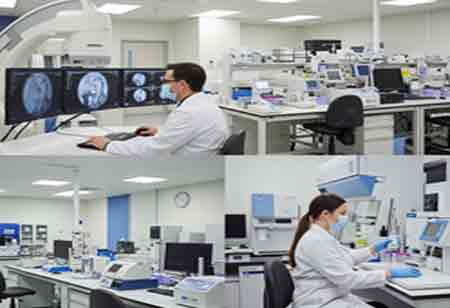Transforming Healthcare Access with Diagnostic Imaging and Laboratory Services in Latin America

Thank you for Subscribing to Medical Care Review Weekly Brief

By
Medical Care Review | Wednesday, June 04, 2025
Stay on top of your health and well-being with exclusive feature stories on the top medical clinics and treatment centers, expert insights and the latest news delivered straight to your inbox. Subscribe today.
Latin America's diagnostic imaging and laboratory service market is undergoing a transformative phase driven by multiple converging forces. Advancements in digital health technologies, including AI, telemedicine, and automation, are revolutionizing service delivery models and expanding access in urban and rural settings. The shift has spurred public and private investment in diagnostic infrastructure, including establishing imaging centers, mobile labs, and teleradiology services. Technology integration is reshaping service delivery and improving efficiency across diagnostic workflows. Medical imaging solutions and laboratory services are foundational to effective healthcare delivery.
AI and ML algorithms are now used to enhance image interpretation, identify anomalies, and support clinical decision-making. In radiology, AI-powered tools can rapidly analyze imaging data, detect abnormalities such as tumors or fractures, and flag urgent cases for immediate review. In laboratory diagnostics, automation platforms streamline specimen handling, testing, and result generation, reducing turnaround times and human error. Telemedicine and remote diagnostics have gained traction in Latin America in underserved regions with limited specialist access.
Market Dynamics and Technological Integration
Demographic shifts and the changing disease burden primarily propel the Latin American diagnostic imaging and laboratory services market. The region is experiencing rapid urbanization, aging populations, and an increase in lifestyle-related diseases such as diabetes, cancer, and cardiovascular conditions. The health challenges require more sophisticated diagnostic procedures and continuous monitoring, thereby driving demand for imaging modalities like MRI, CT scans, PET scans, and X-rays, as well as clinical laboratory services such as pathology, hematology, and molecular diagnostics.
Mobile diagnostic units, digital imaging transmission, and virtual consultations are helping bridge geographic and economic barriers. The innovations are expanding reach and improving diagnostic accuracy and timeliness. Recent trends indicate a growing emphasis on personalized medicine and preventive healthcare. As genomic technologies and biomarker testing become more accessible, laboratories offer more targeted tests to guide treatment decisions and predict disease risk. Companies offering online ordering, home sample collection, and digital result access are rapidly gaining popularity.
Practical Applications and Evolving Needs
In Latin America, these services are increasingly being applied across various healthcare domains, from oncology and cardiology to infectious diseases and maternal health. Imaging technologies are indispensable in detecting tumors, planning surgeries, and guiding minimally invasive procedures. Laboratory tests are critical for identifying pathogens, monitoring glucose levels, and evaluating organ function. They enable early diagnosis, disease staging, treatment monitoring, and post-treatment surveillance. Diagnostic providers must align their offerings with the needs of modern healthcare consumers while ensuring data privacy, affordability, and service quality.
Latin America has faced recurring outbreaks of diseases like dengue, Zika, and tuberculosis, which require robust diagnostic capabilities for effective containment. Rapid diagnostic kits, molecular PCR testing, and serological analysis have become essential tools in tracking disease spread and initiating treatment protocols. Maternal and neonatal health programs rely heavily on imaging and lab tests to ensure safe pregnancies and early intervention. As cancer rates rise across the region, access to high-quality diagnostic imaging and histopathological services has become a priority. Timely detection and accurate staging significantly influence treatment outcomes and survival rates.
Variations in licensing requirements, quality standards, and reimbursement policies can hinder cross-border collaboration and limit market entry for international players. Regional harmonization of diagnostic standards and guidelines is essential. Collaborative platforms involving regulatory authorities, industry stakeholders, and professional bodies can help create unified frameworks that foster innovation while ensuring patient safety. Workforce limitations impact the efficiency and scalability of diagnostic services. A shortage of radiologists, pathologists, and lab technicians can delay diagnoses and compromise accuracy.
Challenges in the Sector and Strategic Solutions
The most pressing issues are infrastructural disparities, regulatory fragmentation, workforce shortages, and cost barriers. Stakeholders must prioritize investment in mobile and modular diagnostic units, which can be deployed in underserved communities. Public-private partnerships (PPPs) can effectively scale infrastructure and improve service distribution. Government agencies can leverage private sector expertise and technology through joint ventures while ensuring affordability and widespread access. Regulatory inconsistency across countries poses another significant challenge.
Affordability remains a persistent barrier, especially in lower-income populations. Diagnostic providers must innovate around cost-efficiency through automation, digital platforms, or tiered pricing models to make services more accessible. Driven by technological innovation, demographic trends, and evolving healthcare needs, the sector is poised for rapid growth and greater integration into public and private health systems. As the future of healthcare becomes increasingly personalized and preventive, diagnostic services will remain at the heart of practical, inclusive, and resilient healthcare systems in Latin America.
Data management and cybersecurity represent additional concerns as digital diagnostics become more prevalent. Diagnostic firms must adopt international standards for data exchange while investing in cybersecurity tools and staff training to prevent breaches and maintain patient trust. The centers are valuable in urban settings where hospital wait times are long. By decentralizing diagnostics, healthcare systems can alleviate pressure on tertiary facilities and improve patient experience. Diagnostic service providers are exploring franchise and partnership models to scale their operations and reach a broader population.
